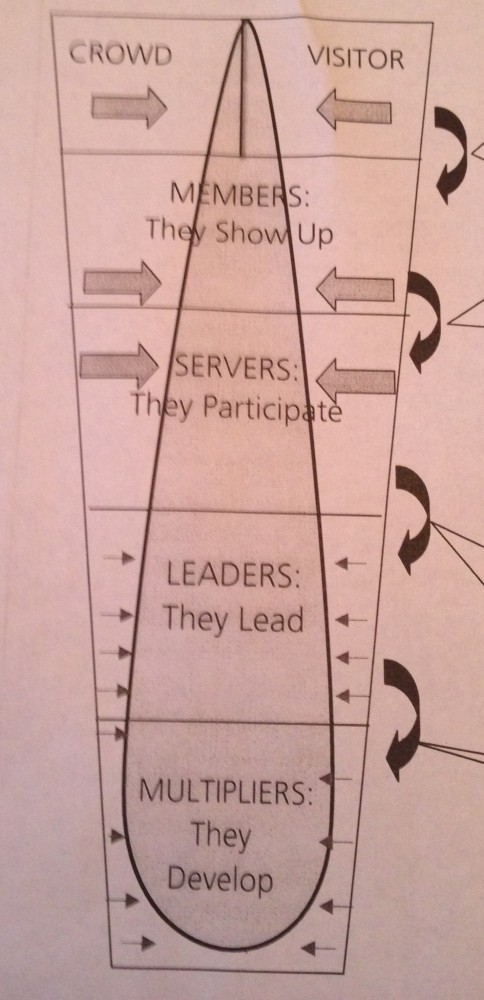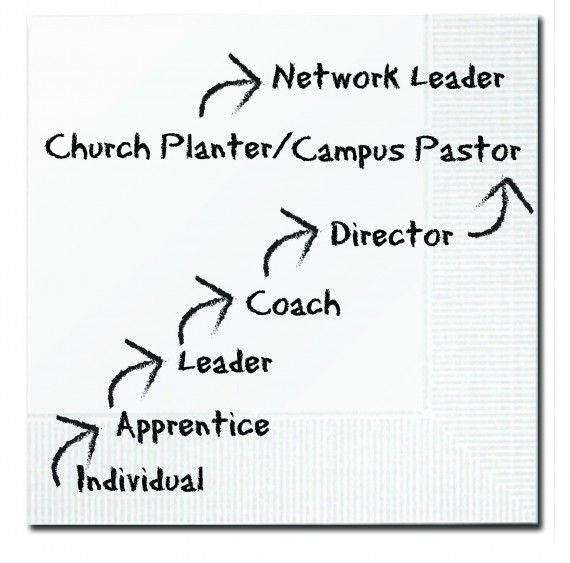
Do you ever feel like your ministry is stuck, jammed or bottlenecked? For whatever reason it just can’t seem to grow to that next level no matter what you do?
May I suggest that it could be that you don’t have a clear pathway for people to develop beyond yourself.
If you are saying things like,
“No one else can develop people like I can” or “If I don’t develop them then who will?”
Then I hate to break it to you: you have probably become the pathway for leaders to grow, and that my friend is a problem.
If your ministry is going to be multiplicative and grow beyond your immediate leadership, then it needs a process that is beyond you. Too many ministers are the process and therefore ministry and discipleship gets bottlenecked with them. The church or fellowship can’t grow beyond a leaders shadow when there is not a clear process of development that is beyond them.
The call of apostolic ministry is to multiply and reach new territories with the gospel. To do so, simple and transferable processes have to be the pathway that every disciple in the ministry follows.
New York/New Jersey

This weekend at our InterVarsity Regional Staff Meetings for SoCal, we had the opportunity to learn from Jason and Sophia Gaboury. They shared with us their process for helping people say “yes” to Jesus and I thought it was great.
They lead the New York/New Jersey Region of InterVarsity and they have seen tremendous growth through student led ministry. Our region had them out to teach us a few things about releasing student leaders on campus.
Currently in New York/New Jersey, they have ministry on more campuses than they have staff. They are reaching almost 4,000 college students and many of the ministries are completely student led.
What is their key to growing almost 100% in the last 8 years?
A solid leadership path.
They have a process that every student in the ministry across the region knows about and follows. Every student that comes into the ministry is developed through this process and given multiple opportunities to say “yes” to Jesus at each threshold or stage. The power of the model (or such models) is that anyone can do it, not just the staff.
Therefore it is transferable and multiplicative.
I don’t think their model is perfect or the one that all of us need to use. But I love that they are using a regional model and I love how it is working for them.
Another Model
Community Christian Church, led by Dave Ferguson, is another ministry that has a great model being used. One that I really like and use in my ministry as well. Here is what theirs looks like. When you talk to Dave, or anyone in their church for that matter, you will hear this language all the time. The disciples in the CCC movement know the pathway and are following it.

What a Good Process Does
A good process of discipleship or development in a ministry does a few things that are absolutely necessary for movement:
- It gets disciplship and development beyond just the staff or pastor
- It is simple and rememberable
- It allows for multiplication
- It forces people to act, not just learn information
- It creates a broad leadership development culture for everyone
What do you think is a key ingredient to a good process of development?

Sign up to receive our blog posts via e-mail and get instant access to our APE Library with videos, seminars, leaders notes, and more.


Good article. Can we get some more details of what each step in the examples above looks like?
I agree with Lindsay re: more details. I think many agree with the model but don’t know the specifics of what is practically involved with moving someone from one stage to another.
We can definitely write an article with the steps. I am sure Jason and Sophia would be glad to do that. I will talk with them.
im all for more details as well. also any book recommendations covering this topic?
I love when churches and ministries have a clearly defined process for developing leaders, because it does help in creating a culture of multiplication. However, I tend to shy away from specific programs or pre-packaged curriculum. Specifics can help in understanding how the model works, but shouldn’t necessarily be replicated. Instead, I advocate a more incarnational and individualized approach to multiplying leaders. This usually means that discipleship and training is more catered to the mentee being developed as opposed to a set of standardized learning materials. For example, I am mentoring several cell groups of 2-3 young men, but doing different types of training with each, based on where they are at in spiritual maturity and ministry experience. One of the helpful books I’ve used is “Exponential’ by Dave and Jon Ferguson, pastors of the mentioned Community Christian Church.
Thanks for the comments asking for more specifics. I’d agree with Joshua Lee Henry above that we want a clear process not a canned curriculum. Here are a few examples of the questions we answer in creating the pathway:
1. How can we ‘engage the crowds’? In Christian circles we tend to put reaching large numbers and developing individuals. This isn’t helpful. Jesus’ ministry never ceased to do both, neither did the early church in the book of acts. So, we need to be clear about how we are going to engage large numbers of people (whether that be missional networks or attractive gathering).
2. What specific invitations are we making to the people we engage? How will we help our friends, networks, or people we meet at a social event to connect with our community?
3. How do we identify and call out those who are gifted to serve and lead? In NYC we’ve used a program called feed 500 as a place where students can have an experience of serving the poor and looking to meet God. As a part of the debrief of this program we’ve invited students to take a step in their own leadership development on campus.
4. What key leadership skills and character traits are you hoping to develop? Often leadership development or mentoring is fuzzy, something in the hazy middle between pastoral counseling, spiritual friendship, and ministry modeling. We’ve decided to clarify our leadership development around 5 skills and our character traits around four pillars. This way we can make specific assignments and create specific opportunities for those with leadership talent.